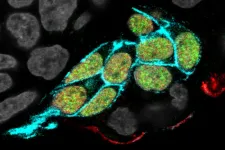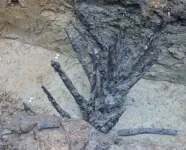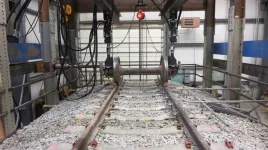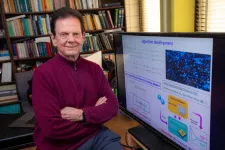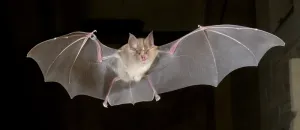(Press-News.org) Different cell types—say, heart, liver, blood, and sperm cells—possess characteristics that help them carry out their unique jobs in the body. In general, those characteristics are hard-wired. Without intervention, a heart cell won’t spontaneously transform into a liver cell.
Yet researchers from the University of Pennsylvania School of Veterinary Medicine, working with collaborators from the University of Texas at San Antonio and Texas Biomedical Research Institute, have prompted marmoset blood cells to acquire the flexibility of stem cells. Then they directed those stem cells to take on the characteristics of sperm precursors.
In the journal eLife, they report on their step-by-step process of rewiring cells. The findings—the first in the marmoset, a small monkey—open new possibilities for studying primate biology and developing novel assisted reproductive technologies like in vitro gametogenesis, a process of generating germ cells, sperm or eggs, in a laboratory dish, akin to how in vitro fertilization involves the generation of an embryo outside the human body.
“Scientists know how to generate functional sperm and egg from induced pluripotent stem cells in mice, but mouse germ cells are very different from human germ cells,” says Kotaro Sasaki, an assistant professor at Penn Vet. “By studying marmosets, whose biology more closely resembles ours, we can bridge the gap.”
To understand how to generate germ cells, the researchers first studied germ cell precursors from marmoset embryos, which had never been rigorously characterized for the species. They found that these early-stage cells, known as primordial germ cells (PGCs), bore certain molecular markers that could be tracked over time. Performing single-cell RNA sequencing on these cells revealed that PGCs expressed genes characteristic of early-stage germ cells and those related to epigenetic modifications, which regulate gene expression. PGCs did not, however, express genes known to be turned on later in the process of germ cell development, when precursor cells migrate to the ovaries or testes to complete their maturation.
Their findings were “consistent with the notion that marmoset germ cells undergo a reprogramming process,” Sasaki says, that “turns off” certain markers and allows PGCs to proceed through the stages of germ cell development. The patterns the researchers observed in marmoset cells closely resembled what has been found in both humans and other monkey species but were distinct from those of mice, another reason why the marmoset could be a valuable model for reproductive biology studies.
With that information in hand, the team set about trying to reconstitute the process of development artificially, in the lab. The first step: to transform blood cells into induced pluripotent stem cells (iPSCs), cells that retain the ability to give rise to a number of other cell types.
“I have a lot of experience in working with cell culture and induced pluripotent stem cells, but establishing a stable culture for the marmoset cells was a difficult part of the study,” says Yasunari Seita, a postdoctoral researcher in Sasaki’s lab and a lead author.
After much trial and error and applying lessons learned from mouse, human, and other investigations, Seita landed upon a strategy that enabled him to generate and sustain stable cultures of iPSCs. A key to success was the addition of an inhibitor of the signaling pathway governed by the Wnt protein, which is involved in a variety of cellular functions, such as cell differentiation.
The next step was to move from iPSCs to germ cell precursors. Once again, considerable experimentation went into developing the protocol for this transformation. The method that worked best involved adding a cocktail of growth factors to successfully prompt between 15-40% of their culture to take on the characteristics of these germ cell precursors.
“We were excited to see that efficiency and were able to expand our cultures, passaging them multiple times and seeing nice, exponential growth,” Sasaki says. “The cells maintained key germ cell markers but didn’t express other markers that are associated with the migration to the gonad.”
In a final stage of the study, the research team coaxed these lab-grown cells to take on the characteristics of later-stage germ cells. Based on a method Sasaki and colleagues had established earlier in human cells and reported in a 2020 Nature Communications paper, they cultured the cells with mouse testicular cells over the course of a month. The result was a successful growth with some cells beginning to turn on genes associated with later-stage sperm cell precursors.
Developing new approaches to study the marmoset sets up the Penn and University of Texas at San Antonio teams—as well as the scientific community in general—to make use of the species as an important research model. Marmosets, for example, have cognitive functioning that resembles that of humans in many ways and thus could lead to new insights in neuroscience.
For Sasaki’s group, most interested in development of the reproductive system, marmosets represent a new avenue for pursuing studies of normal and abnormal development as well as fertility.
“When you think about the clinical applications of an assisted reproductive technology like in vitro gametogenesis, there are a lot of ethical, legal, and safety concerns that could arise,” Sasaki says. “We definitely need a good preclinical model to explore before we move to human clinical translation.”
Kotaro Sasaki is an assistant professor of biomedical sciences at the University of Pennsylvania School of Veterinary Medicine.
Yasunari Seita is a postdoctoral researcher in the School of Veterinary Medicine at Penn.
Sasaki and Seita’s coauthors are Penn Vet’s Keren Cheng; the University of Texas at San Antonio’s John R. McCarrey, Nomesh Yadu, Isamar Santana Toro, Li-hua Yen, Sean Vargas, Christopher S. Navara, and Brian P. Hermann; and the Texas Biomedical Research Institute’s Ian H. Cheeseman, Alec Bagwell, and Corinna N. Ross. Seita and Cheng were co-first authors, and Sasaki, Navara, and Hermann were co-corresponding authors.
The study was supported by the Open Philanthropy Project (grants 197906 and 10080664), National Institutes of Health (grants DA054170, HD090007, OD011133, and MD007591) and National Science Foundation (grants 1337513 and 2018408).
END
Rewiring blood cells to give rise to precursors of sperm
School of Veterinary Medicine researchers teamed with scientists at the University of Texas at San Antonio to transform blood cells to regain a flexible fate, growing into a precursor of sperm cells.
2023-02-21
ELSE PRESS RELEASES FROM THIS DATE:
Hidden from the Romans: 200 tons of silver on the shores of the river Lahn
2023-02-21
When Prof. Markus Scholz, who teaches archaeology and the history of Roman provinces at Goethe University, returned to Bad Ems toward the end of the excavation work, he was astonished: After all, all the photos sent by his colleague Frederic Auth showed but a few pieces of wood. Not surprisingly, Scholz was ill-prepared for what he saw next: a wooden defense construction consisting of sharpened wooden stakes, designed to prevent the enemy’s approach. The martial-looking structure was intended to deter enemies from attacking the camp. Such installations – ...
Air pollution speeds bone loss from osteoporosis: Large study
2023-02-21
Elevated levels of air pollutants are associated with bone damage among postmenopausal women, according to new research led by scientists at Columbia University Mailman School of Public Health. The effects were most evident on the lumbar spine, with nitrous oxides twice as damaging to the area than seen with normal aging.
The research findings appear in the peer-reviewed journal eClinicalMedicine, part of The Lancet Discovery Science suite of open-access journals.
Previous studies on ...
Pain management pathway reduces use of opioids after urethral repair surgery
2023-02-21
February 21, 2022 – For men undergoing surgery to repair scarring in the urethra (urethroplasty), a new approach to pain management can reduce the need for strong opioid drugs without compromising pain control, reports a study in Urology Practice®, an Official Journal of the American Urological Association (AUA). The journal is published in the Lippincott portfolio by Wolters Kluwer.
"Over-prescribing of opioids for postoperative pain control has been a major contributor to the opioid epidemic,” comments senior author ...
CEE team helps DOD develop better analysis and design procedures for rail and roads
2023-02-21
CEE researchers will help the Department of Defense develop better systems to evaluate the structural health of rail lines and modernize pavement design and evaluation procedures in a new project funded by the U.S. Army Engineer Research and Development Center (ERDC) and led by Applied Research Associates Inc.
Within CEE, Professor Erol Tutumluer and Research Associate Professor J. Riley Edwards (MS 06, PhD 19) are leading the work for this multi-year research project called Advancing Power Projection through Lines of Communication (APPLoC). In the first year, the Department of Civil and Environmental Engineering will receive $2.1 million in grant funding.
As a whole, the ...
How to compensate for loss of gene function? Think alternative splicing
2023-02-21
Living organisms have a knack for persisting in the face of challenges. For instance, when genes malfunction, organisms may be able to compensate by activating redundant genes with similar functions, called paralogs.
One example of such compensation are two genes of the muscleblind-like (MBNL) family of RNA-binding proteins that lose their function in Myotonic Dystrophy Type 1, the most common cause of adult-onset muscular dystrophy. Loss of MBNL1 increases the levels of its paralog MBNL2 in tissues where protein expression is low, allowing MBNL2 to functionally compensate for MBNL1 loss. In animal models, loss of one paralog results in ...
Nguyen to receive NSF CAREER Award for NeuralSAT: A constraint-solving framework for verifying deep neural networks
2023-02-21
Thanhvu Nguyen, Assistant Professor, Computer Science, is set to receive funding for the project: "CAREER: NeuralSAT: A Constraint-Solving Framework for Verifying Deep Neural Networks."
Deep Neural Networks (DNNs) have emerged as an effective approach to tackling real-world problems. However, just like traditional software, DNNs can have bugs and be attacked. This naturally raises the question of how DNNs should be tested, validated, and ultimately verified to meet the ...
Pathak and Simon studying airborne and vehicular millimeter-wave wireless networking
2023-02-21
Parth Pathak, Associate Professor, Computer Science, and Robert Simon, Professor, Computer Science, received funding for the project: "Airborne and Vehicular Millimeter-wave Wireless Networking."
Pathak and Simon are developing a state-of-the-art unmanned aerial vehicle (UAV) and unmanned ground vehicle (UGV) mmWave wireless networking and computing software/hardware platform at George Mason University. The platform will consist of battery-powered and gas-electric hybrid hexacopters, vehicular nodes, and ground robots that will be augmented with mmWave ...
Researchers turn to quantum computing power to simulate, study atomic nuclei
2023-02-21
AMES, Iowa – Let’s see, thought James Vary, how can we have a little fun with the name of our $1 million nuclear physics project?
Hmm, can we work in the term hack?
So, it’s “Nuclei and Hadrons with Quantum Computers.” Or, “NuHaQ,” for short.
“It’s a takeoff on ‘hack,’” said Vary, an Iowa State University professor of physics and astronomy and leader of a new project supported by a three-year, $1 million grant from the U.S. Department of Energy. In academic computing circles, “to be a good hacker is a positive compliment. Hackers ...
Speaking up and getting results: New research identifies who employees should talk to at work
2023-02-21
INFORMS Journal Organization Science New Study Key Takeaways:
Choosing who to speak to greatly impacts how ideas are heard and implemented in the workplace.
Employees who speak to managers or bosses who have the authority and resources to address an issue, led to a 12%-15% increase in implementing ideas and subsequent sales performance.
Speaking to peers was associated with a 10% decrease in implemented ideas and subsequent sales performance.
BALTIMORE, MD, February 21, 2023 – Is speaking up at work worth it? New research in the INFORMS journal Organization Science finds that new ideas can be heard and implemented in the office, but it depends on who employees talk to.
“There ...
First stem cells from a bat species known to harbor SARS-CoV-2 could shed light on virus survival and molecular adaptability
2023-02-21
Researchers from the Icahn School of Medicine at Mount Sinai have generated the first induced pluripotent stem cells (iPSCs) from bats, gaining valuable insights into the close relationship between bats and viruses. This research opens the door to studying how viruses like SARS-CoV-2, which causes COVID-19, survive, spread, and evade the immune system through molecular adaptations to new hosts.
The team’s findings, published February 21 in Cell, may also shed light on the unique properties of bats that underlie their remarkable defenses against aging and cancer.
“Our study suggests that bats have evolved mechanisms to tolerate a large ...
LAST 30 PRESS RELEASES:
Bluey’s dad offered professorial chair in archaeology at Griffith University
Beyond small data limitations: Transfer learning-enabled framework for predicting mechanical properties of aluminum matrix composites
Unveiling non-thermal catalytic origin of direct current-promoted catalysis for energy-efficient transformation of greenhouse gases to valuable chemicals
Chronic breathlessness emerging as a hidden strain on hospitals
Paleontologists find first fossil bee nests made inside fossil bones
These fossils were the perfect home for ancient baby bees
Not everyone reads the room the same. A new study examines why.
New research identifies linked energy, immune and vascular changes in ME/CFS
Concurrent frailty + depression likely boost dementia risk in older people
Living in substandard housing linked to kids’ missed schooling and poor grades
Little awareness of medical + psychological complexities of steroid cream withdrawal
Eight in 10 trusts caring for emergency department patients in corridors, finds BMJ investigation
NASA’s Webb telescope finds bizarre atmosphere on a lemon-shaped exoplanet
The gut bacteria that put the brakes on weight gain in mice
Exploring how patients feel about AI transcription
Category ‘6’ tropical cyclone hot spots are growing
Video: Drivers struggle to multitask when using dashboard touch screens, study finds
SLU research shows surge in alcohol-related liver disease driving ‘deaths of despair’
Rising heat reshapes how microbes break down microplastics, new review finds
Roots reveal a hidden carbon pathway in maize plants
Membrane magic: FAMU-FSU researchers repurpose fuel cells membranes for new applications
UN Member States pledge to increase access to diagnosis and inhaled medicines for the 480 million people living with COPD
Combination therapy shows potential to treat pediatric brain cancer ATRT
Study links seabird nesting to shark turf wars in Hawai‘i
Legal sports betting linked to sharp increases in violent crime, study finds
Breakthrough AI from NYUAD speeds up discovery of life-supporting microbes
New Eva Mayr-Stihl Foundation funding initiative boosts research at University of Freiburg on adaptation of forests to global change
The perfect plastic? Plant-based, fully saltwater degradable, zero microplastics
Bias in data may be blocking AI’s potential to combat antibiotic resistance
Article-level metrics would provide more recognition to most researchers than journal-level metrics
[Press-News.org] Rewiring blood cells to give rise to precursors of spermSchool of Veterinary Medicine researchers teamed with scientists at the University of Texas at San Antonio to transform blood cells to regain a flexible fate, growing into a precursor of sperm cells.
